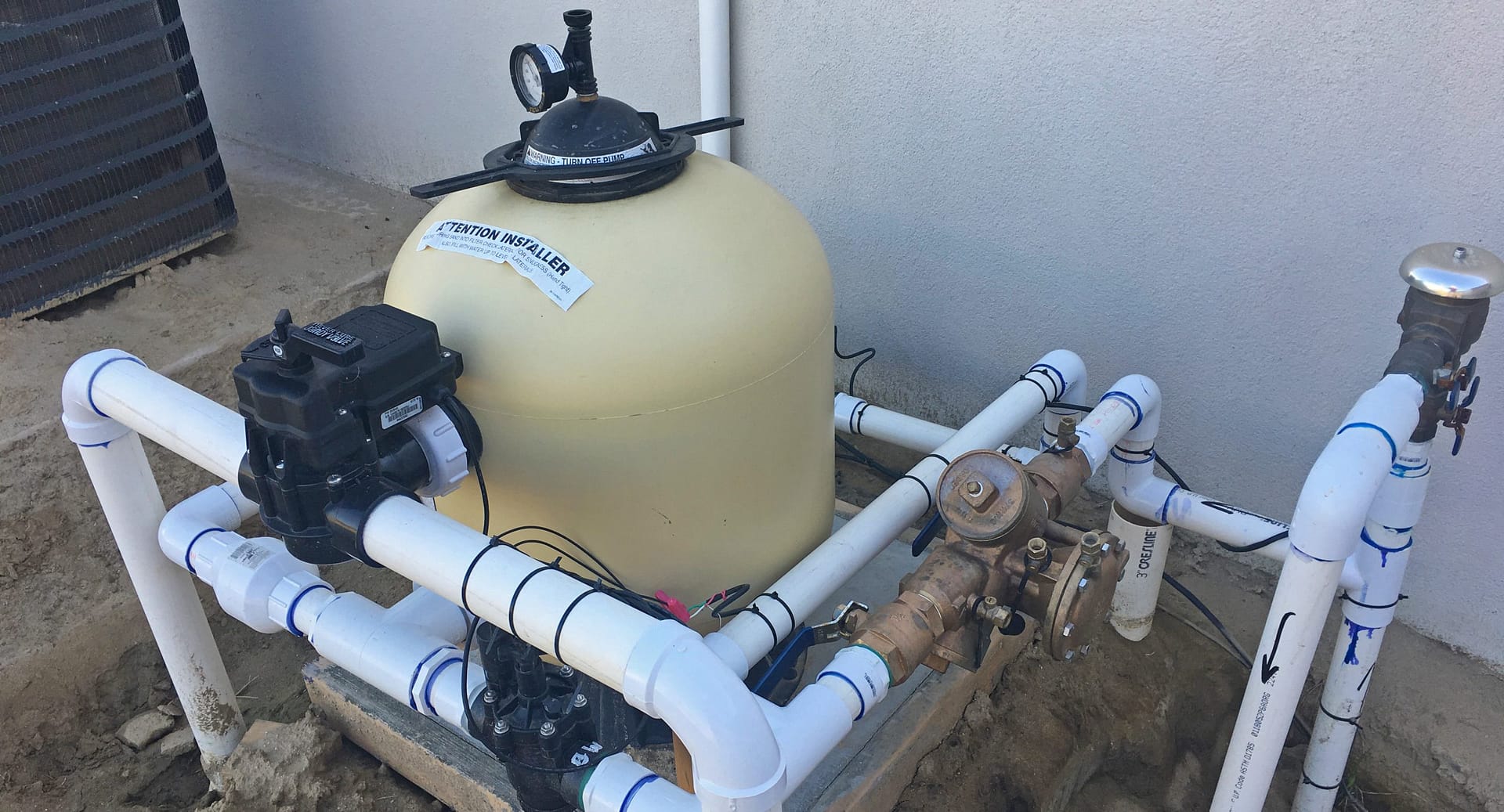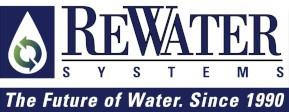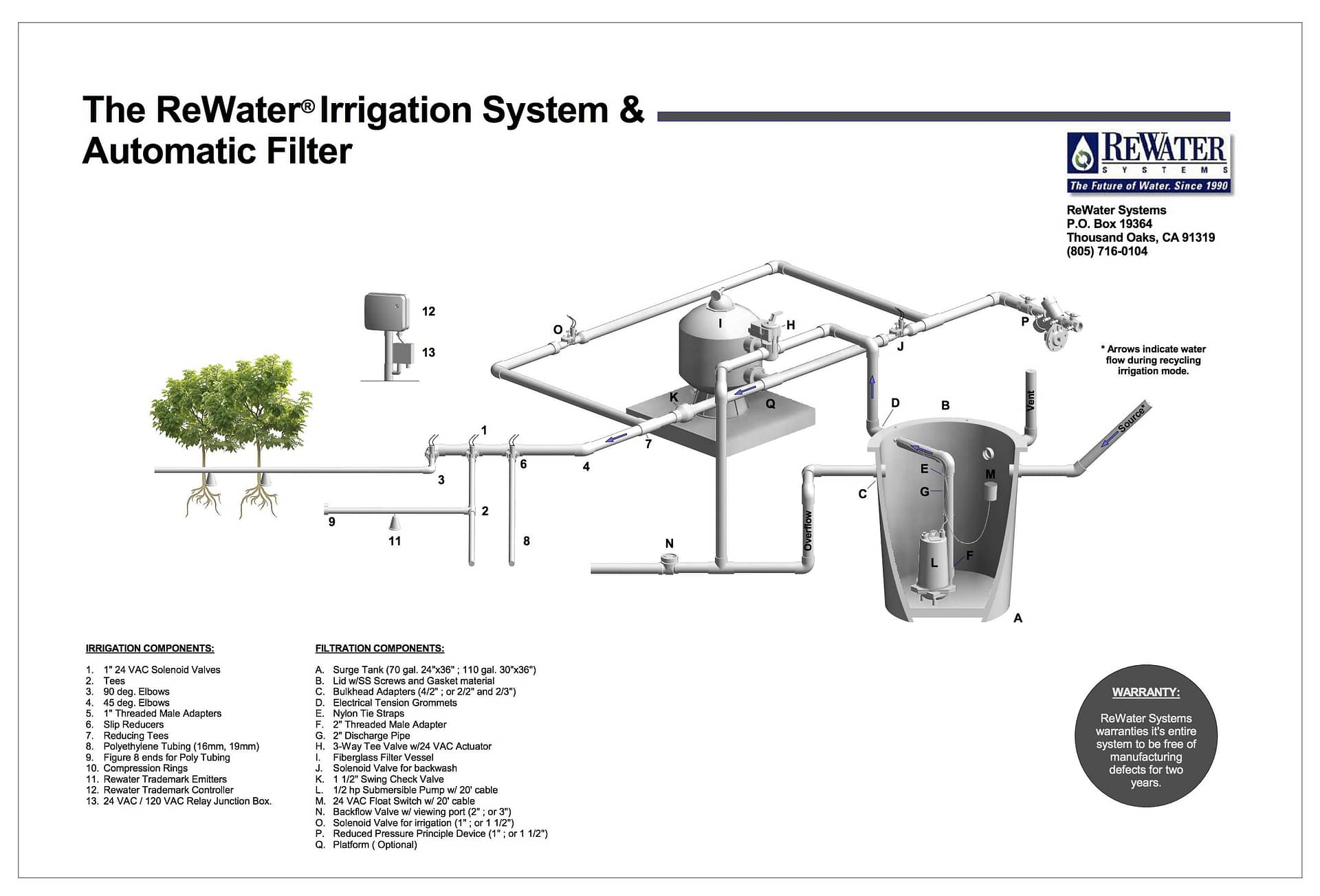
ReWater’s filter units use your water immediately according to your irrigation programs on our controller. If using greywater, our process keeps it from turning septic and saves you from buying a large tank that needs expensive UV or ozone and constant cleaning.
In all our systems, if you don’t produce enough reusable water to satisfy your irrigation demand by midnight, our controllers automatically supplement with city water, rain, or both:
- Single Family ReWater Irrigation System & Automatic Filter
- Commercial Greywater Filter System (non Los Angeles version)
- Commercial Greywater Filter System (Los Angeles Compliant)
- Res/Com poly tank with lint interceptor in vault. LA Compliant.
- Grey & Rain System
- Commercial Greywater filter with Rain (LID Compliance Version)
- Grey & Rain System on Grading Plan
Code requires both the filter unit and the drip irrigation to be approved for untreated greywater. Anything less will clog up over time. All the filter systems above use ReWater’s proprietary underground drip irrigation (not shown) to form a complete ReWater® system.
The systems above were engineered for a specific landscape and are incorrect for any other landscape.
All drawings and copyright are owned by ReWater Systems. All rights reserved.
Our Filters are Tailored to Your Irrigation Needs
Our single family and multi-family systems all work on the same principle. First, we size your system according to your landscape’s needs. Then we filter and use the greywater immediately as it’s produced, according to the irrigation program(s) required by your landscape. This process keeps organically rich greywater full of oxygen, which is great for plants.
Untreated Greywater is Better
We don’t “treat” greywater because treatment kills the nutrients that plants love about greywater. Treatment is not required because the water is used immediately. Our time-proven untreated greywater systems thus save homeowners tens of thousands of dollars and apartment owners hundreds of thousands of dollars in acquisition, operation, and maintenance costs over the life of the system compared to treatment systems.
Our process also results in relatively small filter systems requiring very little space. In an apartment building situation, you’ll save tens of thousands of dollars in footprint costs alone.
Rain Harvesting
Rain harvesting can be added to any ReWater system with the addition of our RWJB-2 pump relay junction box. This allows you to satisfy Low Impact Development (LID) mandates and/or to earn LEED points with one inexpensive system. Don’t buy two systems just because you have two types of water!
Do it Right the First Time
There’s probably nothing we haven’t successfully dealt with when it comes to on-site water reuse for irrigation. Call us at (eight oh five) 716-0104 to discuss how we can help you and your building professionals with design, construction drawings, permit acquisition, and on-site construction.
How a ReWater filter system operates
As shown in the drawing of the single-family system below, when float switch (M) rises on greywater in tank (A), if irrigation is programmed for that day, ReWater controller (13) signals pump (L) to start, which sends greywater to the top of sand filter vessel (I) and down through the sand. The sand traps the hair, lint, and other debris in tiny spaces between sand particles.
Filtered (“untreated”) greywater then travels out to a series of irrigation valves using ReWater’s emitters (1) as programmed for use in the landscape.
Our controller starts and stops in the irrigation program(s) throughout a 24-hour day based on greywater availability, sending a small dose of filtered greywater to each irrigation valve sequentially, as programmed for that day. This spreads greywater evenly around the landscape, until all valve times are satisfied.
At the end of each day, if all valves weren’t satisfied with greywater, valve (O) is opened to pressurize all the valves with city water. Then, any balance of irrigation is provided with city water.
A Self-Cleaning Filter
Our controller backwashes the sand filter based on accumulated irrigation run-time. On that signal, debris captured in sand filter (I) is automatically removed by the controller rotating 3-way valve (H), then opening city water valve (J), allowing city water to rush into the bottom of sand filter (I). That water lifts the debris out through one-way valve (N) to the sewer. Finally, the controller resets everything for the next day’s irrigation schedule.
Systems within Los Angeles County or the City of Los Angeles will store the city water in a second tank, where a pump will send the stored water through the sand filter for cleaning. That tank is often a large rain tank that satisfies your Low Impact Development (LID) requirements.


